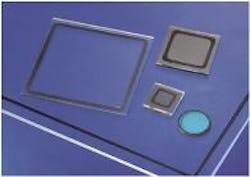Packaging temperature-sensitive components by laser glass soldering
Aachen, Germany - Sensitive component groups such as optical sensors in medical technology, OLED components or dye solar cells require reliable encapsulation so that neither water nor oxygen can reach the interior of the component, thereby possibly impairing its functionality. Conventionally, such components are joined with anodic or glass-frit bonding or they are simply glued together. These bonds, however, are not stable enough over the long term. In addition, the entire component group is heated when it is bonded, which is why the process is not suitable for bonding temperature-sensitive components.
Fraunhofer ILT scientists have developed a process that enables them to reduce the total heating of the component to be encapsulated to a minimum and, thus, prevent thermally induced stress in the process zone. By using laser-based joining with glass solder they can hermetically join temperature-sensitive glass/glass as well as glass/ceramics components groups that exhibit long-term stability. They have developed the process to such an extent that large components can also be encapsulated.
During the laser-based soldering of glass, the laser beam is guided precisely over the workpiece and applies the energy solely into the glass solder itself to melt it. The substrates to be joined are heated only via heat conduction to wet them; this way, the overall heating of the component group can be reduced to a minimum. An appropriate radiation approach for this is quasi-simultaneous laser soldering: a highly dynamic 2D scanner system guides the laser beam over the solder contour many times at a high speed and evenly heats the entire glass solder contour up to processing temperature by means of a laser power-time profile. After both joining pairs have been bonded, the temperature in the processing zone is lowered according to the profile without creating stress.
The team at the Fraunhofer ILT will design the entire production chain for its partners. From initial steps to prepare the process, such as the selection of an appropriate glass solder, via the application of the glass solder by means of screen printing all the way to the pre-vitrification of the pairs to be joined in a convection oven. Especially for laser-based glass soldering, the researchers have developed processing heads as well as positioning and clamping technologies to guarantee homogenous and reproducible packaging in either ambient or inert protective gas atmospheres.
For more information, contact Elmar Gehlen, Dipl.-Ing. at [email protected]
